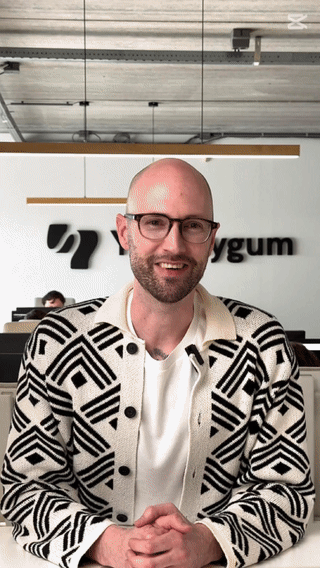You've hit product-market fit. Growth is steady, maybe even fast. Your platform solves real problems, your user base is expanding, and your team is scaling with it. But something's off. Hiring slows down. Conversion dips. Investors like the numbers, but not the narrative. And eventually someone says it: "Your brand doesn't match who you've become."
This post breaks down why brand identity isn't about looking slick - it's about shaping perception, building trust, and removing friction. We'll show where brand missteps cost scale-ups more than they think, and how to build a brand that actually keeps up with growth.
Why brand matters once you've hit PMF
In the early startup phase, branding tends to be an afterthought - and that's understandable. The focus is on building, shipping, and validating. Maybe a founder chose a typeface that felt fresh, or a freelance designer put together a decent color palette. Good enough, for a while.
But once your platform reaches PMF, the brand becomes something else entirely: a signal. Of quality, vision, trust. If your identity is still anchored to the company you were two years ago, it can quietly start blocking momentum. Especially when entering new markets or targeting new segments. You feel it in slower hiring, fuzzier positioning, or investor hesitation. When your look, tone, and story no longer match your trajectory, brand becomes a bottleneck.
Cool ≠ Consistent
It's easy to get caught up in what looks cool. Bold colors, slick fonts, a homepage that pops. But when your platform experience doesn't match the promise your brand made, you've got a problem. Trust erodes fast.
Consistency isn't about being boring. It's about clarity. A brand that feels aligned across your website, platform, and messaging builds recognition and credibility. That doesn't mean chasing originality for its own sake. It means sticking to a clear identity your audience can actually remember and rally around.
A few patterns we keep seeing:
Banking on brand equity that doesn't really exist. Familiar to your team doesn't mean meaningful to your users.
Cherry-picking trends from successful companies and hoping it adds up to something coherent.
Letting internal opinions drown out strategic clarity. Design by committee leads to brand mush.
Expecting your product team to handle branding - often resulting in UI-flavored aesthetics with no deeper foundation.
Thinking the visual identity can live apart from your platform's experience.
Strong brand identity starts with where you're headed, not where you've been. And that sometimes means uncomfortable calls: choosing what fits your market over what your founding team personally prefers.
Your platform is part of your brand experience
Most people think of branding as the marketing site. But your platform is where users actually decide if they believe you. It's where your brand promise meets real behavior.
If you say you simplify payroll, but your setup flow is a mess and mobile support is broken, your credibility tanks. If you champion agility but deliver clunky, uninspired UX, your platform becomes a contradiction.
Wise gets this right. Their bold visuals and no-nonsense tone amplify their promise of disrupting international money transfers. The platform delivers on that clarity and confidence. Same with Fiverr: their energetic brand flows through every step of hiring creative talent, from onboarding to repeat work. No brand gap, no user confusion.
Scaling your brand through Design Systems
To keep your brand consistent across screens, teams, and time zones, you need a Design System. But not just any Design System. One rooted in your brand foundations, not just component libraries.
When identity is clearly defined, it can be translated into tokens, spacing, type scales, tone of voice, and more. Primary brand colors become button states. Typography balances personality and readability. Even microcopy feels like it's speaking in your voice.
Design Systems help teams ship faster. But more importantly, they protect your brand from inconsistency. Whether it's your in-house devs or an outside freelancer building that next flow, everyone's working from the same playbook.
From guidelines to usable assets
Let's be real: a PDF with logo margins and font rules isn't enough. If your brand guidelines don't help designers, developers, and marketers actually do their jobs, they're not guidelines. They're decoration.
We often see brand guidelines that skew too print-focused. Fonts that don't render well in product UIs. Colors that fail accessibility. Layout rules that break the moment you try to implement them in real-world platforms.
Usable brand guidelines start with the practical. And when done right, they not only empower your in-house team but make it easy to work with partners and scale content without constant creative oversight.
How we approach brand with growth in mind
At Yummygum, we don't just deliver strategy or polished visuals. We turn brands into systems that support scale - across marketing and platform.
That means:
Brand Guidelines that work beyond the PDF
Asset libraries for day-to-day marketing
Component-ready styling for dev handoff
Custom templates in tools your marketing team is more familiar with, like Canva or Figma Buzz, so internal teams can create campaigns without going off-brand
A good example: On My Way, the D2C brand launched by PlanGo. We helped define a brand identity that was fun, energetic, and easy to roll out. It extended smoothly across their native mobile app, a high-converting marketing site, and a comprehensive set of on-brand Canva assets their marketing team could run with.
Final thoughts
Your brand shouldn’t hold back your platform, or your growth. If your identity feels dated, disconnected, or hard to use, it’s time for a rethink. Want your brand to scale as fast as your platform? Let’s map what’s holding you back.








